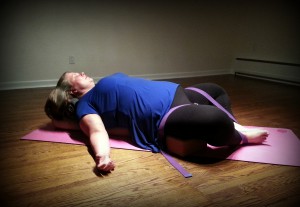Supta Bada Konasana (Reclining Bound Angle Pose)
Supta Bada Konasana is a jewel from Restorative Yoga that I like to include in Restorative classes, as well as in longer Hatha classes for an opening guided relaxation.
Supta Bada Konasana has many benefits — don’t be fooled by its soft appearance! There is so much going on. Because I’m an anatomy geek, let me share with you some of the effects I find anatomically magical, among a few others:
• Possibly my favourite effect is what happens due to the unique supported leg position: with hips and knees in flexion, and hips in supported abduction (i.e., out to the sides on blocks, no stretch in the groin), and with the pelvis slightly tipped forward by the bolster behind the back, all the muscles that usually pull on the pelvis are slackened. This allows the pelvis to relax into a slackened sling, and be guided into alignment by the structure of the props. It’s awesome: the psoas, QL’s, erector spinae, quads, hams, gluts, adductors—even piriformis!—are all slackened.
Coupled with the feet together and bound, the legs stay aligned, thus allowing the pelvis to find alignment between the femurs.
• The chest is pressed open to the sky by the bolster behind the back, the weight of the free arms pulling the shoulders to the ground. Because this can often be held for minutes by beginners, and 15 or 20 minutes by more experienced practitioners, connective tissue across the chest and anterior shoulders can be gently but effectively lengthened. It’s also a great position to explore all the movements of the ribcage when breathing, and on deep breathing, a great way to stretch open the muscles and sinews between and around the ribs. This open-hearted position is also used in yoga therapy to treat depression and heart conditions.
• The position of the neck on a high support (here a chunky folded blanket), with the chin coming toward the throat, gently lengthens the back of the neck. When held for minutes at a time, it can have a significant effect on the often shortened connective tissue there (major cause of tension headaches). This position also bows the forehead to the chest, a symbolic way to surrender the ego and honour the greater wisdom of the heart, and is also a meditation technique used to calm the mind.
This pose, like so many others in Restorative Yoga, also helps us to challenge our need to constantly do.
So often we need to spend time undoing before doing. As a teacher, I love it for its many benefits and because it’s so beginner-friendly. As a practitioner, I love it because it feels like coming home.
Tiina Veer
Yoga for Round Bodies Retreat
Aug 16-18, 2013





